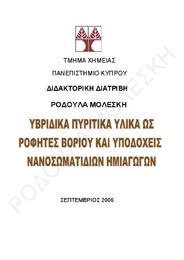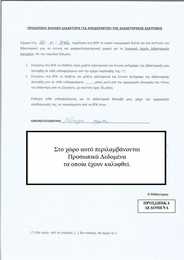| dc.contributor.advisor | Λεοντίδης, Επαμεινώνδας | el |
| dc.contributor.author | Μολέσκη, Ροδοθέα Γ. | el |
| dc.coverage.spatial | Κύπρος | el |
| dc.coverage.spatial | Cyprus | en |
| dc.creator | Μολέσκη, Ροδοθέα Γ. | el |
| dc.date.accessioned | 2012-09-21T07:35:15Z | |
| dc.date.accessioned | 2017-08-03T10:40:49Z | |
| dc.date.available | 2012-09-21T07:35:15Z | |
| dc.date.available | 2017-08-03T10:40:49Z | |
| dc.date.issued | 2006-11 | |
| dc.date.submitted | 2006-11-28 | |
| dc.identifier.uri | https://gnosis.library.ucy.ac.cy/handle/7/39430 | en |
| dc.description | Αριθμός δεδηλωμένων πηγών στη βιβλιογραφία: 368 | el |
| dc.description | Διατριβή (διδακτορική) -- Πανεπιστήμιο Κύπρου, Σχολή Θετικών και Εφαρμοσμένων Επιστημών, Τμήμα Χημείας, Σεπτέμβριος 2006. | el |
| dc.description | Η βιβλιοθήκη διαθέτει αντίτυπο της διατριβής σε έντυπη μορφή. | el |
| dc.description.abstract | Στο παρόν διδακτορικό συντέθηκαν πυριτικά υλικά με τη μέθοδο sol-gel τα οποία έχουν χρησιμοποιηθεί σε δυο διαφορετικές εφαρμογές. Η πρώτη εφαρμογή είναι η ανάπτυξη μεθοδολογίας για ρόφηση βορικών ανιόντων από υδατικά συστήματα που μπορεί να χρησιμοποιηθεί στον καθαρισμό υπόγειων νερών και του νερού της αφαλάτωσης από βόριο. Η δεύτερη εφαρμογή είναι η εισαγωγή στο πυριτικό υλικό κατάλληλα τροποποιημένων νανοσωματιδίων ημιαγωγών, ώστε να αποφεύγεται η συσσωμάτωσή τους. Στόχος είναι η δημιουργία σύνθετων υλικών με ενδιαφέρουσες οπτικές, καταλυτικές κ.α. ιδιότητες. Για τη σύνθεση πυριτικών υλικών για ρόφηση βορικών ανιόντων από υδατικά διαλύματα έχουν χρησιμοποιηθεί τρεις μεθοδολογίες. Στην πρώτη μεθοδολογία γίνεται απλός εγκλεισμός συμπλεκτικών μορίων στο πυριτικό υλικό. Στη δεύτερη γίνεται ομοιοπολική δέσμευση κατάλληλων υποκαταστατών στο πυριτικό υλικό. Στην τρίτη μεθοδολογία γίνεται ομοιοπολική δέσμευση υποκαταστατών που περιέχουν ομάδες ροφητές βορίου σε μεσοπορώδη πυρίτια. Τα πιο επιτυχημένα από αυτά τα υλικά συντέθηκαν με ομοιοπολική δέσμευση υποκαταστατών στο πυριτικό υλικό και με εφαρμογή της μεθοδολογίας του «ατομικού» imprinting. Τα υλικά αυτά παρουσιάζουν καλές ροφητικές ιδιότητες, συγκρίσιμες με χωρητικότητες που παρουσιάζουν εμπορικές ρητίνες. Στο δεύτερο μέρος αυτού του διδακτορικού συντέθηκαν νανοσωματίδια ημιαγωγών σε μικρογαλακτώματα, τα οποία σταθεροποιήθηκαν με τη χρήση σταθεροποιητικών μορίων του τύπου Χ(CH2)nSi(OCH3)3, που περιέχουν στο ένα τους άκρο τη σταθεροποιητική ομάδα Χ και στο άλλο τους άκρο μεθοξυπυριτικές ομάδες που μπορούν να συμπολυμεριστούν με αλκοξυσιλάνια. Στο παρόν διδακτορικό συντέθηκαν τα σουλφιίδια CdS, PbS και ZnS και τα οξείδια TiO2 και ZnO Σε όλες τις περιπτώσεις διαπιστώθηκε ότι τα νανοσωματίδια διατηρούν το κβαντικό τους μέγεθος μετά την εισαγωγή τους στο πυριτικό υλικό. | el |
| dc.description.abstract | In the present PhD thesis we have used the sol-gel method to synthesize silica-based materials for two specific applications. The first application is the removal of boron from aqueous solutions, and its goal is the development of a methodology that can eventually be used to remove boron from subsurface water and desalinated water. The second application is the introduction of surface-modified semiconductor nanoparticles within silicate materials, so that their aggregation is avoided. The goal is to protect the nanoparticles and to create composite materials with interesting optical, catalytic e.t.c properties. For the first application we have used three different synthetic procedures. The first method is the simple inclusion of molecules with boron-chelating groups in a sol-gel matrix. In the second procedure, appropriate ligands are covalently bound to the sol-gel matrix. In the third method, boron-chelating ligands are covalently bound to mesoporous silica matrices. The most successful materials were those synthesized with covalent binding of ligands to sol-gel matrix, using the method of atomic imprinting. Those materials aquire good sorption properties and high capacities for borate. Some of the synthesized materials have boron capacities comparable to those of industrial resins cyrrently used for boron removal. In the second part of this thesis, semiconductor nanoparticles were produced in microemulsions and stabilized using stabilizing agents of the general formula: Χ(CH2)nSi(OCH3)3 which contain an X group for attachment to the nanoparticle surface and methoxysilylgroups that can be copolymerized with the silica matrix. We have synthesized the sulfide nanoparticles CdS, PbS and ZnS and the oxides TiO2 and ZnO In all cases it was found that the nanoparticles retain their quantum size when inserted in the silicate material. | en |
| dc.format.extent | 332 σ. : εικ., πίνακ., διαγρ. ; 30 εκ. | el |
| dc.language.iso | gre | en |
| dc.publisher | Πανεπιστήμιο Κύπρου, Σχολή Θετικών και Εφαρμοσμένων Επιστημών / University of Cyprus, Faculty of Pure and Applied Sciences | |
| dc.rights | info:eu-repo/semantics/openAccess | en |
| dc.rights | Open Access | en |
| dc.subject.lcsh | Silicon compounds | en |
| dc.subject.lcsh | Boron | en |
| dc.subject.lcsh | Nanoparticles | en |
| dc.subject.lcsh | Semiconductors | en |
| dc.title | Υβριδικά πυριτικά υλικά ως ροφήτες βορίου και υποδοχείς νανοσωματιδίων: διδακτορική διατριβή | el |
| dc.title.alternative | Hybrid silicate materials as boron sorbents and as host matrices for semiconductor nanoparticles | en |
| dc.type | info:eu-repo/semantics/doctoralThesis | en |
| dc.contributor.committeemember | Λεοντίδης, Επαμεινώνδας | el |
| dc.contributor.committeemember | Θεοχάρης, Χάρης | el |
| dc.contributor.committeemember | Πατρίκιος, Κώστας | el |
| dc.contributor.committeemember | Πετρίδης, Δημήτριος | el |
| dc.contributor.committeemember | Καρακασίδης, Μιχάλης | el |
| dc.contributor.committeemember | Leontides, Epameinondas | en |
| dc.contributor.committeemember | Theocharis, Charis | en |
| dc.contributor.committeemember | Patrikios, Costas | en |
| dc.contributor.committeemember | Petridis, Dimitrios | en |
| dc.contributor.committeemember | Karakassides, Michael | en |
| dc.contributor.department | Πανεπιστήμιο Κύπρου, Σχολή Θετικών και Εφαρμοσμένων Επιστημών, Τμήμα Χημείας | el |
| dc.contributor.department | University of Cyprus, Faculty of Pure and Applied Sciences, Department of Chemistry | en |
| dc.subject.uncontrolledterm | ΜΕΘΟΔΟΣ SOL-GEL | el |
| dc.subject.uncontrolledterm | ΥΛΙΚΑ ΒΑΣΙΣΜΕΝΑ ΣΤΗΝ ΠΥΡΙΤΙΑ | el |
| dc.subject.uncontrolledterm | ΡΟΦΗΣΗ ΒΟΡΙΚΩΝ ΑΝΙΟΝΤΩΝ | el |
| dc.subject.uncontrolledterm | ΜΕΣΟΠΟΡΩΔΗ ΥΛΙΚΑ | el |
| dc.subject.uncontrolledterm | ΝΑΝΟΣΩΜΑΤΙΔΙΑ ΗΜΙΑΓΩΓΩΝ | el |
| dc.subject.uncontrolledterm | ΟΠΤΙΚΕΣ ΙΔΙΟΤΗΤΕΣ ΝΑΝΟΣΩΜΑΤΙΔΙΩΝ ΗΜΙΑΓΩΓΩΝ | el |
| dc.subject.uncontrolledterm | ΣΤΑΘΕΡΟΠΟΙΗΣΗ ΝΑΝΟΣΩΜΑΤΙΔΙΩΝ ΗΜΙΑΓΩΓΩΝ | el |
| dc.subject.uncontrolledterm | SOL-GEL METHOD | en |
| dc.subject.uncontrolledterm | SILICA-BASED MATERIALS | en |
| dc.subject.uncontrolledterm | SORPTION OF BORATE ANIONS | en |
| dc.subject.uncontrolledterm | MESOPOROUS MATERIALS | en |
| dc.subject.uncontrolledterm | SEMICONDUCTOR NANOPARTICLES | en |
| dc.subject.uncontrolledterm | OPTICAL PROPERTIES OF SEMICONDUCTOR NANOPARTICLES | en |
| dc.subject.uncontrolledterm | STABILIZATION OF SEMICONDUCTOR NANOPARTICLES | en |
| dc.identifier.lc | QD181.S6M65 2006 | en |
| dc.author.faculty | Σχολή Θετικών και Εφαρμοσμένων Επιστημών / Faculty of Pure and Applied Sciences | |
| dc.author.department | Τμήμα Χημείας / Department of Chemistry | |
| dc.type.uhtype | Doctoral Thesis | en |
| dc.rights.embargodate | 2006-11-28 | |
| dc.contributor.orcid | Λεοντίδης, Επαμεινώνδας [0000-0003-4427-0398] | |



